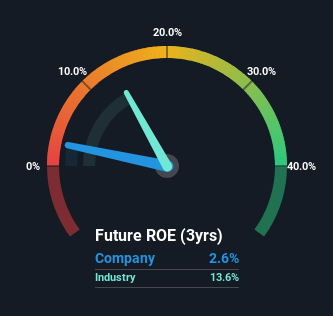- Greece
- /
- Trade Distributors
- /
- ATSE:XYLEK
Should You Be Concerned About Interwood-Xylemporia A.T.E.N.E.'s (ATH:XYLEK) ROE?

One of the best investments we can make is in our own knowledge and skill set. With that in mind, this article will work through how we can use Return On Equity (ROE) to better understand a business. By way of learning-by-doing, we'll look at ROE to gain a better understanding of Interwood-Xylemporia A.T.E.N.E. (ATH:XYLEK).
ROE or return on equity is a useful tool to assess how effectively a company can generate returns on the investment it received from its shareholders. In short, ROE shows the profit each dollar generates with respect to its shareholder investments.
Check out our latest analysis for Interwood-Xylemporia A.T.E.N.E
How Do You Calculate Return On Equity?
ROE can be calculated by using the formula:
Return on Equity = Net Profit (from continuing operations) ÷ Shareholders' Equity
So, based on the above formula, the ROE for Interwood-Xylemporia A.T.E.N.E is:
2.6% = €223k ÷ €8.5m (Based on the trailing twelve months to June 2023).
The 'return' is the yearly profit. So, this means that for every €1 of its shareholder's investments, the company generates a profit of €0.03.
Does Interwood-Xylemporia A.T.E.N.E Have A Good ROE?
One simple way to determine if a company has a good return on equity is to compare it to the average for its industry. Importantly, this is far from a perfect measure, because companies differ significantly within the same industry classification. If you look at the image below, you can see Interwood-Xylemporia A.T.E.N.E has a lower ROE than the average (14%) in the Trade Distributors industry classification.

That certainly isn't ideal. That being said, a low ROE is not always a bad thing, especially if the company has low leverage as this still leaves room for improvement if the company were to take on more debt. A company with high debt levels and low ROE is a combination we like to avoid given the risk involved. Our risks dashboard should have the 5 risks we have identified for Interwood-Xylemporia A.T.E.N.E.
The Importance Of Debt To Return On Equity
Companies usually need to invest money to grow their profits. That cash can come from retained earnings, issuing new shares (equity), or debt. In the case of the first and second options, the ROE will reflect this use of cash, for growth. In the latter case, the debt required for growth will boost returns, but will not impact the shareholders' equity. Thus the use of debt can improve ROE, albeit along with extra risk in the case of stormy weather, metaphorically speaking.
Interwood-Xylemporia A.T.E.N.E's Debt And Its 2.6% ROE
It seems that Interwood-Xylemporia A.T.E.N.E uses a huge volume of debt to fund the business, since it has an extremely high debt to equity ratio of 3.57. The combination of a rather low ROE and high debt to equity is a negative, in our book.
Summary
Return on equity is a useful indicator of the ability of a business to generate profits and return them to shareholders. Companies that can achieve high returns on equity without too much debt are generally of good quality. All else being equal, a higher ROE is better.
Having said that, while ROE is a useful indicator of business quality, you'll have to look at a whole range of factors to determine the right price to buy a stock. Profit growth rates, versus the expectations reflected in the price of the stock, are a particularly important to consider. Check the past profit growth by Interwood-Xylemporia A.T.E.N.E by looking at this visualization of past earnings, revenue and cash flow.
But note: Interwood-Xylemporia A.T.E.N.E may not be the best stock to buy. So take a peek at this free list of interesting companies with high ROE and low debt.
New: AI Stock Screener & Alerts
Our new AI Stock Screener scans the market every day to uncover opportunities.
• Dividend Powerhouses (3%+ Yield)
• Undervalued Small Caps with Insider Buying
• High growth Tech and AI Companies
Or build your own from over 50 metrics.
Have feedback on this article? Concerned about the content? Get in touch with us directly. Alternatively, email editorial-team (at) simplywallst.com.
This article by Simply Wall St is general in nature. We provide commentary based on historical data and analyst forecasts only using an unbiased methodology and our articles are not intended to be financial advice. It does not constitute a recommendation to buy or sell any stock, and does not take account of your objectives, or your financial situation. We aim to bring you long-term focused analysis driven by fundamental data. Note that our analysis may not factor in the latest price-sensitive company announcements or qualitative material. Simply Wall St has no position in any stocks mentioned.
About ATSE:XYLEK
Interwood-Xylemporia A.T.E.N.E
Engages in manufacturing and trading wood products in Greece.
Excellent balance sheet and fair value.
Market Insights
Community Narratives



